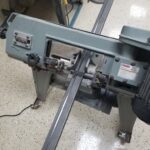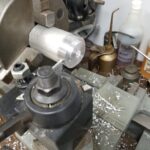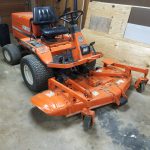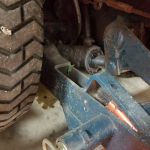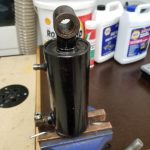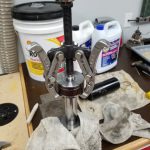Kubota F2000 Lift Cylinder Re-Seal
Tonight I rebuilt a leaking hydraulic cylinder on the mower. The leak was coming from the scraper/seal that seals the rod to the end of the cylinder. Unfortunately since the end of the rod is larger than the seal, the cylinder has to be disassembled to replace it. The process went as follows:
#1 – Remove cylinder from mower.
#2 – Remove the internal cir-clip that holds the cylinder end inside the cylinder bore. This was extremely fiddly and took 20min or so with dental picks and small screwdrivers to get the end of the clip pulled out.
#3 – Remove the cylinder end and piston/rod from the cylinder bore. The cylinder end’s O-ring catches on the cylinder’s cir-clip groove, so while it moves freely to a position that’s ‘almost’ out of the bore the last bit of movement requires clamping the rod in place and persuading the cylinder downwards with a hammer.
#4 – With the piston/rod/end removed from the cylinder, the nut can be loosened and the piston removed. The piston is a press fit and requires a gear puller to remove and a hydraulic press to reinstall.
#5 – With the piston removed the cylinder end slides off of the rod and the scraper/seal can be replaced. The scraper has it’s own small cir-clip that’s much easier to remove.
#6 – Re-assembly is the opposite of assembly, while I was at it I also replaced the cylinder end O-Ring.
#7 – Reinstall
After the rebuild the mower no longer has any hydraulic leaks; the last remaining leak is an engine oil leak that I’ll be tracking down next…
Garage floor finished, leaf harvest begins
I didn’t get “after” pictures from the garage floor project, but it’s visible in the mower pictures below. Overall it turned out very well and will be much easier to keep clean.
The leaves are falling this time of year and if left alone they are able to form a mat several inches thick over the entire yard/house/driveway/garage every few days. To combat this in years past I’ve used an arsenal of leafblowers, rakes, and mowers; the secret weapon in this arsenal though is the 33″ snapper rear engine rider from the mid 1970’s. It’s not great as a mower since the long single blade does not conform to the terrain; but as a leaf collection device there’s nothing better since the single long blade moves tons of air (think airplane prop). This moving air carries all of the leaves/sticks/nuts off of the yard and into the collection bag.
The mower’s deck had taken a beating from using it for trail-clearing; and once the deck deformed enough the blade began to wear against it. I’m replacing the blade and welding the deck back together so it can get back to clearing leaves. In the process of fixing the deck I may also add some sort of reinforcement or “cow catcher” to the front to prevent future damage.









